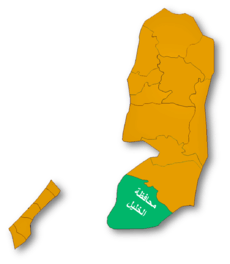Umm al-Khair, Hebron
| Umm al-Khair | |
|---|---|
| Other transcription(s) | |
| • Also spelled | Umm al-Kheir (unofficial) |
 Umm al-Khair Location of Umm al-Khair within Palestine | |
| Coordinates: 31°25′29.60″N 35°11′46.41″E / 31.4248889°N 35.1962250°ECoordinates: 31°25′29.60″N 35°11′46.41″E / 31.4248889°N 35.1962250°E | |
| Governorate | Hebron |
| Government | |
| • Type | Village council |
| Population (2007) | |
| • Jurisdiction | 516 |
| Name meaning | The cairn of Umm Kheir[1] |
Umm al-Khair (Arabic: أم الخير) is a Palestinian village located in the Hebron Governorate of the southern West Bank.
History
In 1883, the Palestine Exploration Fund's Survey of Western Palestine noted "piles of stones" at Rujm Umm Kheir.[2]
The Palestinian villagers, settled there several decades ago after Israel expelled them from the Arad desert, and purchased the land from residents in the Palestinian village of Yatta.[3] According to David Shulman, the nearby settlement, Carmel, lies on lands appropriated from the Bedouin of that village.[4]
Human rights activists and reporters have criticized the lack of amenities for the villagers while settlers nearby enjoy modern life. According to Nicholas Kristof of The New York Times Carmel is
'a lovely green oasis that looks like an American suburb. It has lush gardens, kids riding bikes and air-conditioned homes. It also has a gleaming, electrified poultry barn that it runs as a business.' Beyond its barbed wire fencing, the Bedouins of Umm al-Kheir in shanties are denied connection to the electricity grid, barns for their livestock and toilets, and all attempts to build permanent dwellings are demolished. Elad Orian, an Israeli human rights activist, noted that the chickens of Carmel's poultry farm get more electricity and water than the Palestinian Bedouin nearby. [5]
Hammerman writes as follows:
Right next to the stately country homes - complete with air-conditioning, drip-irrigation gardens and goldfish ponds - a few extended families including old men, old women and infants live in dwellings made of tin, cloth and plastic siding, though there are a few cinder-block structures, too. They tread on broken, barren ground. They have no running water. They are not connected to the power grid that lights up every settlement and outpost in this remote region. They have no access road.[3]
References
- ↑ Palmer, 1881, p. 406
- ↑ Conder and Kitchener, 1883, SWP III, p. 378
- ↑ 3.0 3.1 Ilana Hammerman, 'West Bank settlement is outdoing its neighboring Bedouin village,' Haaretz 11 November, 2011
- ↑ David Shulman, ‘Truth and Lies in South Hebron,’ Jewish Quarterly 18 June 2013.'Um al-Khair, a ramshackle collection of tents and huts and simple stone houses and sheep-pens and corrugated shacks that borders, tragically, on the settlement of Carmel in the South Hebron hills. Or rather, historically, Carmel borders on Um al-Khair, since the lands appropriated for the settlement in the early 80s all belonged to the Bedouin goat-herders and farmers who live on this rocky hill..'
- ↑ Nicholas Kristof, 'The Two Sides of a Barbed-Wire Fence,', The New York Times 30 June, 2010.
Bibliography
- Conder, Claude Reignier; Kitchener, H. H. (1883). The Survey of Western Palestine: Memoirs of the Topography, Orography, Hydrography, and Archaeology 3. London: Committee of the Palestine Exploration Fund.
- Palmer, E. H. (1881). The Survey of Western Palestine: Arabic and English Name Lists Collected During the Survey by Lieutenants Conder and Kitchener, R. E. Transliterated and Explained by E.H. Palmer. Committee of the Palestine Exploration Fund.
External links
- Articles on Ta'ayush website
- Al Faqir (Umm al Kheir) Village Profile, Applied Research Institute–Jerusalem (ARIJ)
- The priorities and needs for development in Al Faqir (Umm al Kheir) village based on the community and local authorities’ assessment, ARIJ
- SWP map 21, IAA
- SWP map 21, Wikimedia commons
| ||||||||||||||||||||
